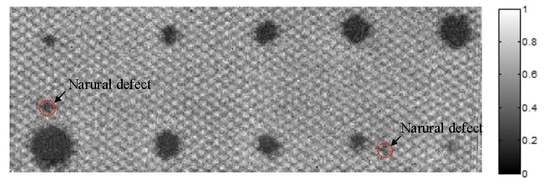Detection and Characterization of Debonding Defects in Aeronautical Honeycomb Sandwich Composites Using Noncontact Air-Coupled Ultrasonic Testing Technique
Abstract
1. Introduction
2. Theory and Model
2.1. Finite Element Method
2.2. Finite Element Model
2.2.1. The Development Model
2.2.2. Finite Element Mesh and Time Step
3. Specimen and Experimental Setup
3.1. Specimen
3.2. Experimental Setup
4. Results and Discussion
4.1. The Mode of Acoustic Wave in Honeycomb Sandwich Composite
4.2. Defect Characterization Using Air-Coupled Ultrasonic Wave
4.3. Actual Detection of Debonding Defect Based on Air-Coupled Ultrasonic Testing
4.4. Image of Debonding Defect with Air-Coupled Ultrasonic Waves
5. Conclusions
Author Contributions
Conflicts of Interest
References
- Paik, J.K.; Thayamballi, A.K.; Kim, G.S. The strength characteristics of aluminum honeycomb sandwich panels. Thin-Walled Struct. 1999, 35, 205–231. [Google Scholar] [CrossRef]
- Foo, C.C.; Seah, L.K.; Chai, G.B. Low-velocity impact failure of aluminium honeycomb sandwich panels. Compos. Struct. 2008, 85, 20–28. [Google Scholar] [CrossRef]
- Cosenza, C.; Kenderian, S.; Djordjevic, B.B.; Green, R.E.; Pasta, A. Generation of narrowband antisymmetric Lamb waves using a formed laser source in the ablative regime. IEEE Trans. Ultrason. Ferroelectr. Freq. Control 2007, 54, 147–156. [Google Scholar] [CrossRef] [PubMed]
- Hay, T.R.; Wei, L.; Rose, J.L.; Hayashi, T. Rapid inspection of composite skin-honeycomb core structures with ultrasonic guided waves. J. Compos. Mater. 2003, 37, 929–939. [Google Scholar] [CrossRef]
- Blouin, A.; Campagne, B.; Néron, C.; Monchalin, J.P. Detection of skin disbond in honeycombs and coating detachment by a laser acoustic technique. In AIP Conference Proceedings; AIP: Melville, NY, USA, 2007; Volume 894, pp. 1140–1147. [Google Scholar]
- Ma, B.; Zhou, Z.; Zhao, H.; Zhang, D.; Liu, W. Characterisation of inclusions and disbonds in honeycomb composites using non-contact non-destructive testing techniques. Insight-Non-Destr. Test. Cond. Monit. 2015, 57, 499–507. [Google Scholar] [CrossRef]
- Taylor, J.O.; Dupont, H.M. Thermographic inspection of metallic honeycomb sandwich structures. In Review of Progress in Quantitative Nondestructive Evaluation; Springer: Boston, MA, USA, 1999; pp. 1373–1380. [Google Scholar]
- Hagemaier, D.J. NDT of aluminium-brazed titanium honeycomb structure. Non-Destr. Test. 1976, 9, 107–116. [Google Scholar] [CrossRef]
- Zhao, H.; Zhou, Z.; Fan, J.; Li, G.; Sun, G. Application of lock-in thermography for the inspection of disbonds in titanium alloy honeycomb sandwich structure. Infrared Phys. Technol. 2017, 81, 69–78. [Google Scholar] [CrossRef]
- Döring, J.; Bovtun, V.; Gaal, M.; Bartusch, J.; Erhard, A.; Kreutzbruck, M.; Yakymenko, Y. Piezoelectric and electrostrictive effects in ferroelectret ultrasonic transducers. J. Appl. Phys. 2012, 112, 084505. [Google Scholar] [CrossRef]
- Li, H.; Zhou, Z. Air-coupled ultrasonic signal processing method for detection of lamination defects in molded composites. J. Nondestruct. Eval. 2017, 36, 45. [Google Scholar] [CrossRef]
- Pallav, P.; Gan, T.H.; Hutchins, D.A. Elliptical-Tukey chirp signal for high-resolution, air-coupled ultrasonic imaging. IEEE Trans. Ultrason. Ferroelectr. Freq. Control 2007, 54, 1530–1540. [Google Scholar] [CrossRef]
- Hutchins, D.; Burrascano, P.; Davis, L.; Laureti, S.; Ricci, M. Coded waveforms for optimised air-coupled ultrasonic nondestructive evaluation. Ultrasonics 2014, 54, 1745–1759. [Google Scholar] [CrossRef] [PubMed]
- Waag, G.; Hoff, L.; Norli, P. Air-coupled ultrasonic through-transmission thickness measurements of steel plates. Ultrasonics 2015, 56, 332–339. [Google Scholar] [CrossRef] [PubMed]
- Chimenti, D.E. Review of air-coupled ultrasonic materials characterization. Ultrasonics 2014, 54, 1804–1816. [Google Scholar] [CrossRef] [PubMed]
- Bass, H.E.; Sutherland, L.C.; Zuckerwar, A.J.; Blackstock, D.T.; Hester, D.M. Atmospheric absorption of sound: Further developments. Acoust. Soc. Am. J. 1995, 97, 680–683. [Google Scholar] [CrossRef]
- Achim, A.; Bezerianos, A.; Tsakalides, P. Novel Bayesian multiscale method for speckle removal in medical ultrasound images. IEEE Trans. Med. Imaging 2001, 20, 772–783. [Google Scholar] [CrossRef] [PubMed]
- Abd-Elmoniem, K.Z.; Youssef, A.B.; Kadah, Y.M. Real-time speckle reduction and coherence enhancement in ultrasound imaging via nonlinear anisotropic diffusion. IEEE Trans. Biomed. Eng. 2002, 49, 997–1014. [Google Scholar] [CrossRef] [PubMed]
- Gan, T.H.; Hutchins, D.A.; Billson, D.R.; Schindel, D.W. The use of broadband acoustic transducers and pulse-compression techniques for air-coupled ultrasonic imaging. Ultrasonics 2001, 39, 181–194. [Google Scholar] [CrossRef]
- Fowle, E.N.; Carey, D.R.; Vander Schuur, R.E.; Yost, R.C. A pulse compression system employing a linear FM Gaussian signal. Proc. IEEE 1963, 51, 304–312. [Google Scholar] [CrossRef]
- Kretschmer, F.F.; Welch, L.R. Sidelobe reduction techniques for polyphase pulse compression codes. In Proceedings of the Record of the IEEE 2000 International Radar Conference, Alexandria, VA, USA, 12–12 May 2000; pp. 416–421. [Google Scholar]
- Zhao, Y.; Shen, Z.; Lu, J.; Ni, X. Simulation of leaky Rayleigh wave at air–solid cylindrical interfaces by finite element method. Ultrasonics 2006, 44, e1169–e1172. [Google Scholar] [CrossRef]
- Kažys, R.; Demčenko, A.; Žukauskas, E.; Mažeika, L. Air-coupled ultrasonic investigation of multi-layered composite materials. Ultrasonics 2006, 44, e819–e822. [Google Scholar] [CrossRef]
- Xu, X.F.; Qiao, P. Homogenized elastic properties of honeycomb sandwich with skin effect. Int. J. Solids Struct. 2002, 39, 2153–2188. [Google Scholar]
- Sohn, Y.; Krishnaswamy, S. Mass spring lattice modeling of the scanning laser source technique. Ultrasonics 2002, 39, 543–551. [Google Scholar] [CrossRef]
- Lei, X.; Heng, Z.; Shangkai, G. Barker code in TCD ultrasound systems to improve the sensitivity of emboli detection. Ultrasound Med. Biol. 2009, 35, 94–101. [Google Scholar] [CrossRef] [PubMed]
- Garcia-Rodriguez, M.; Yañez, Y.; Garcia-Hernandez, M.; Salazar, J.; Turo, A.; Chavez, J.A. Lamb wave generation with an air-coupled piezoelectric array using square chirp excitation. In Proceedings of the 19th International Congress on Acoustics, Madrid, Spain, 2–7 September 2007. [Google Scholar]
- Garcia-Rodriguez, M.; Yañez, Y.; Garcia-Hernandez, M.J.; Salazar, J.; Turo, A.; Chavez, J.A. Application of Golay codes to improve the dynamic range in ultrasonic Lamb waves air-coupled systems. NDT E Int. 2010, 43, 677–686. [Google Scholar] [CrossRef]
- Li, H.; Zhou, Z. Application of P4 Polyphase codes pulse compression method to air-coupled ultrasonic testing systems. Ultrasonics 2017, 78, 57–69. [Google Scholar] [CrossRef] [PubMed]
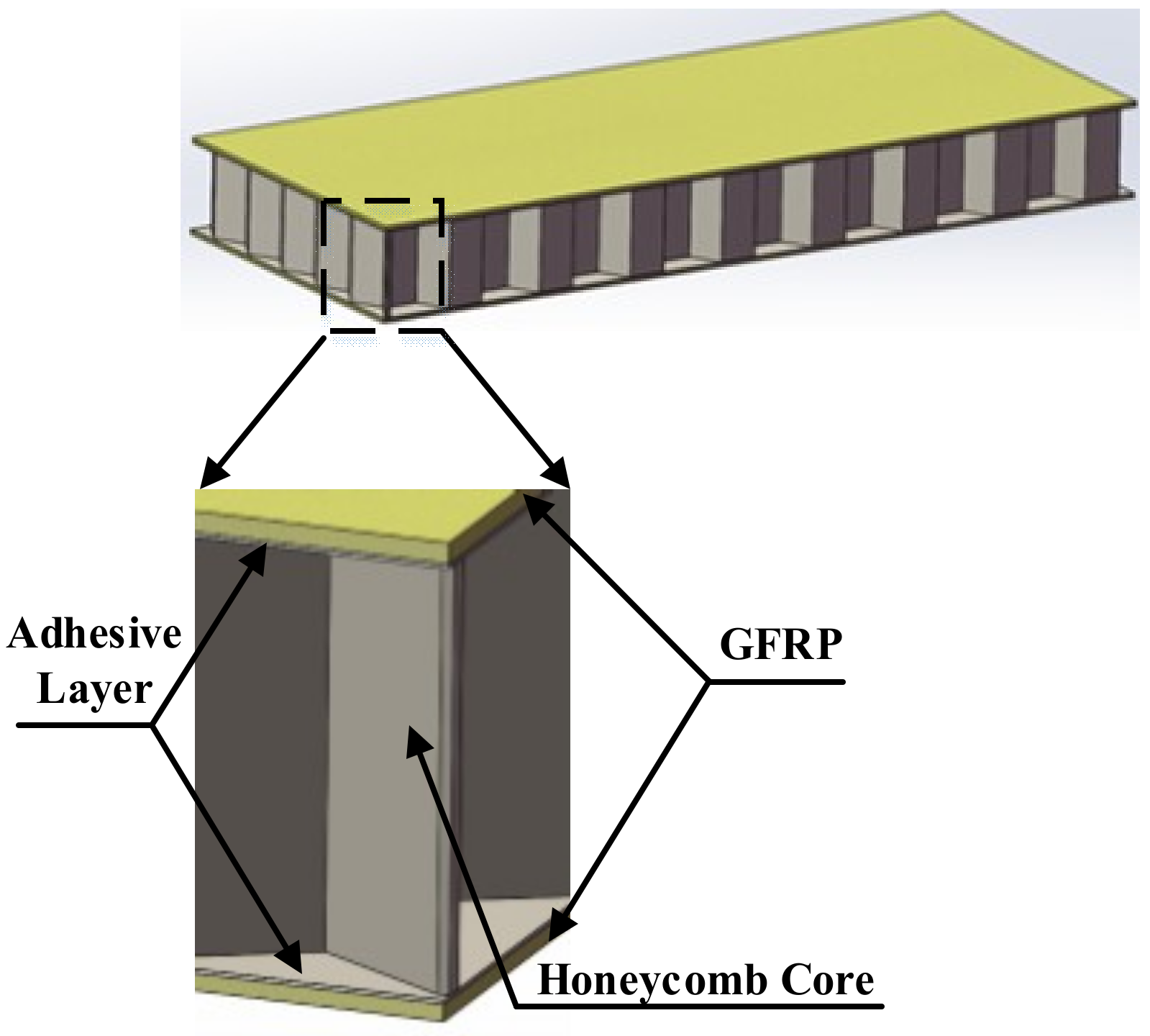
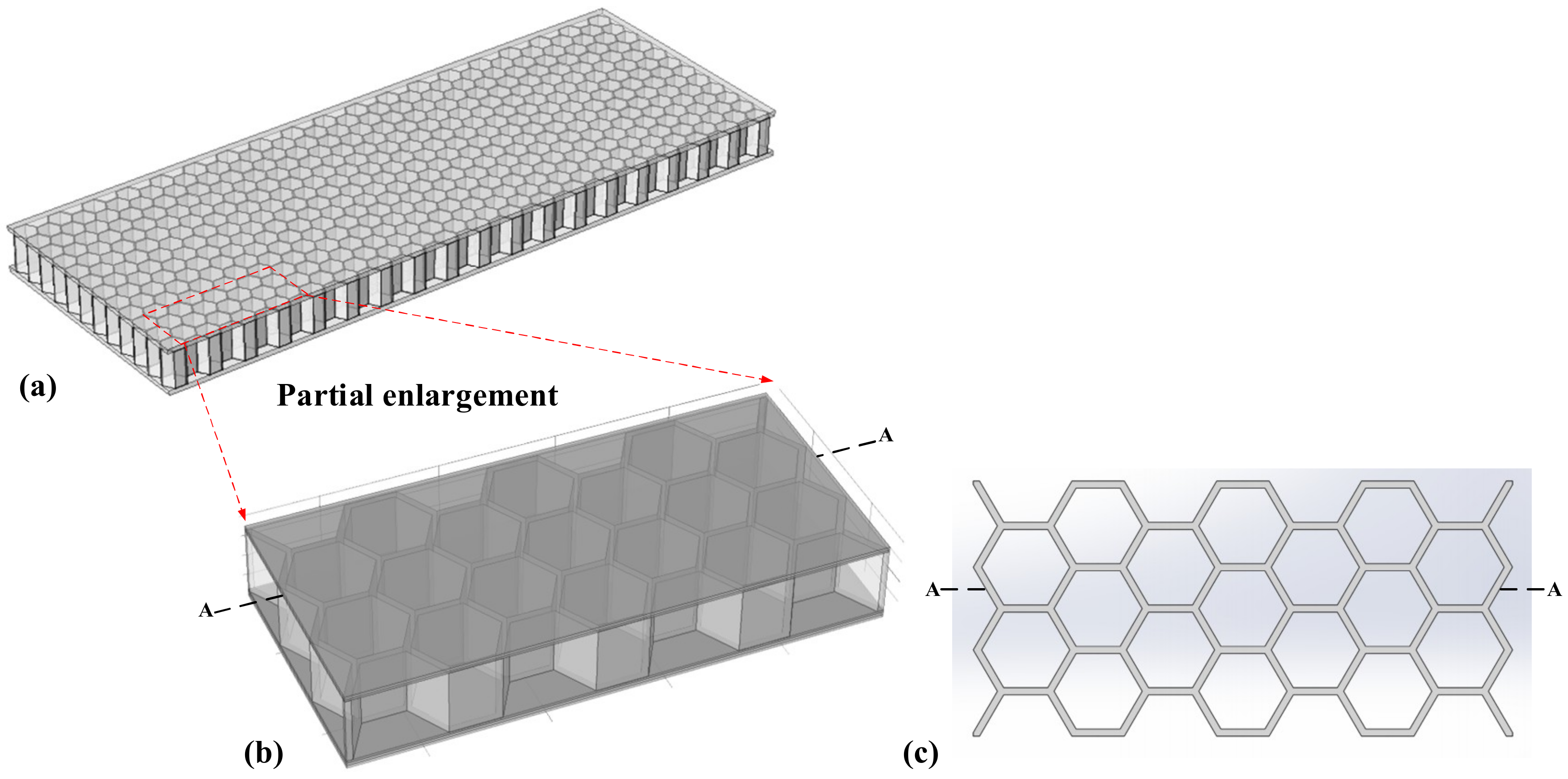
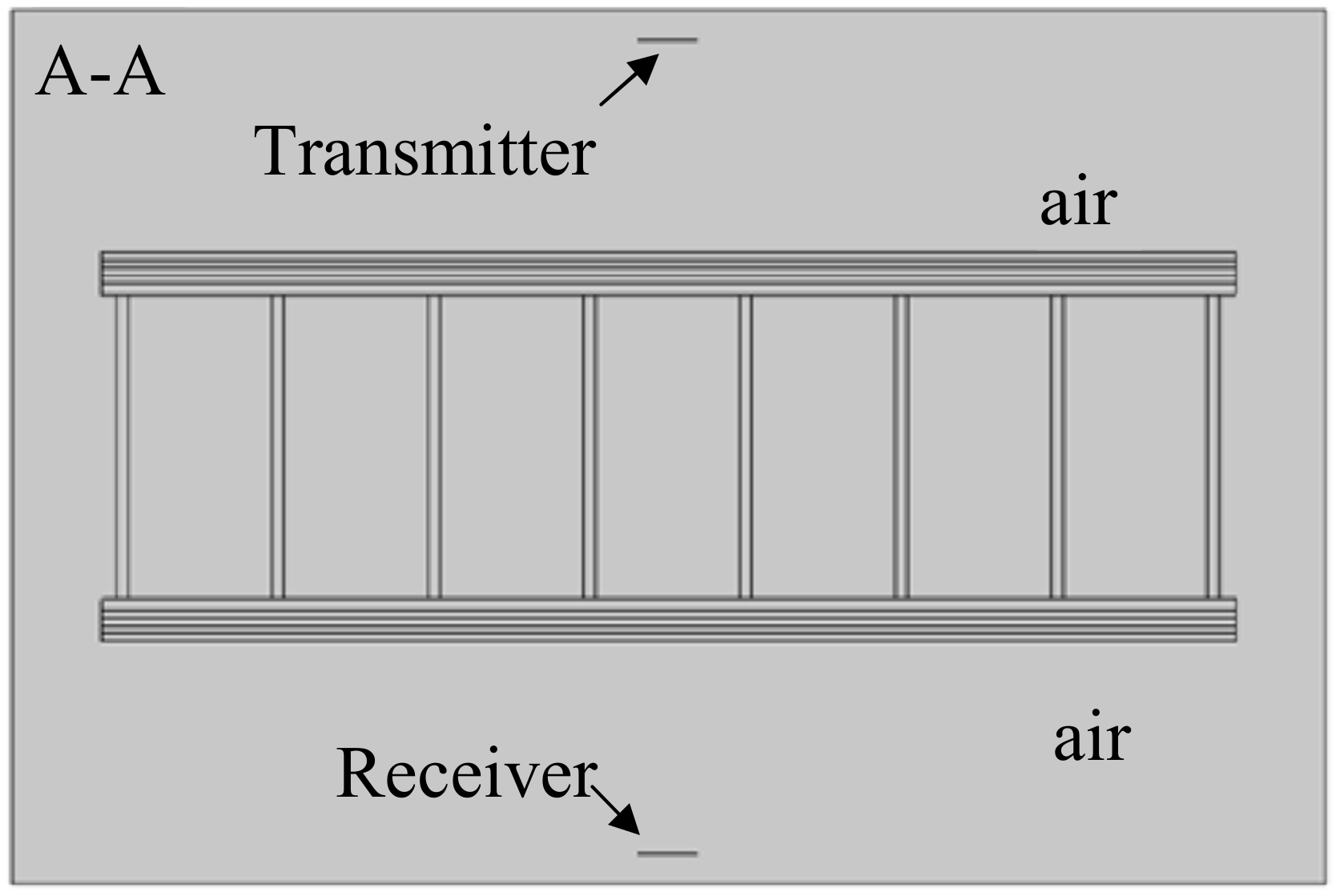
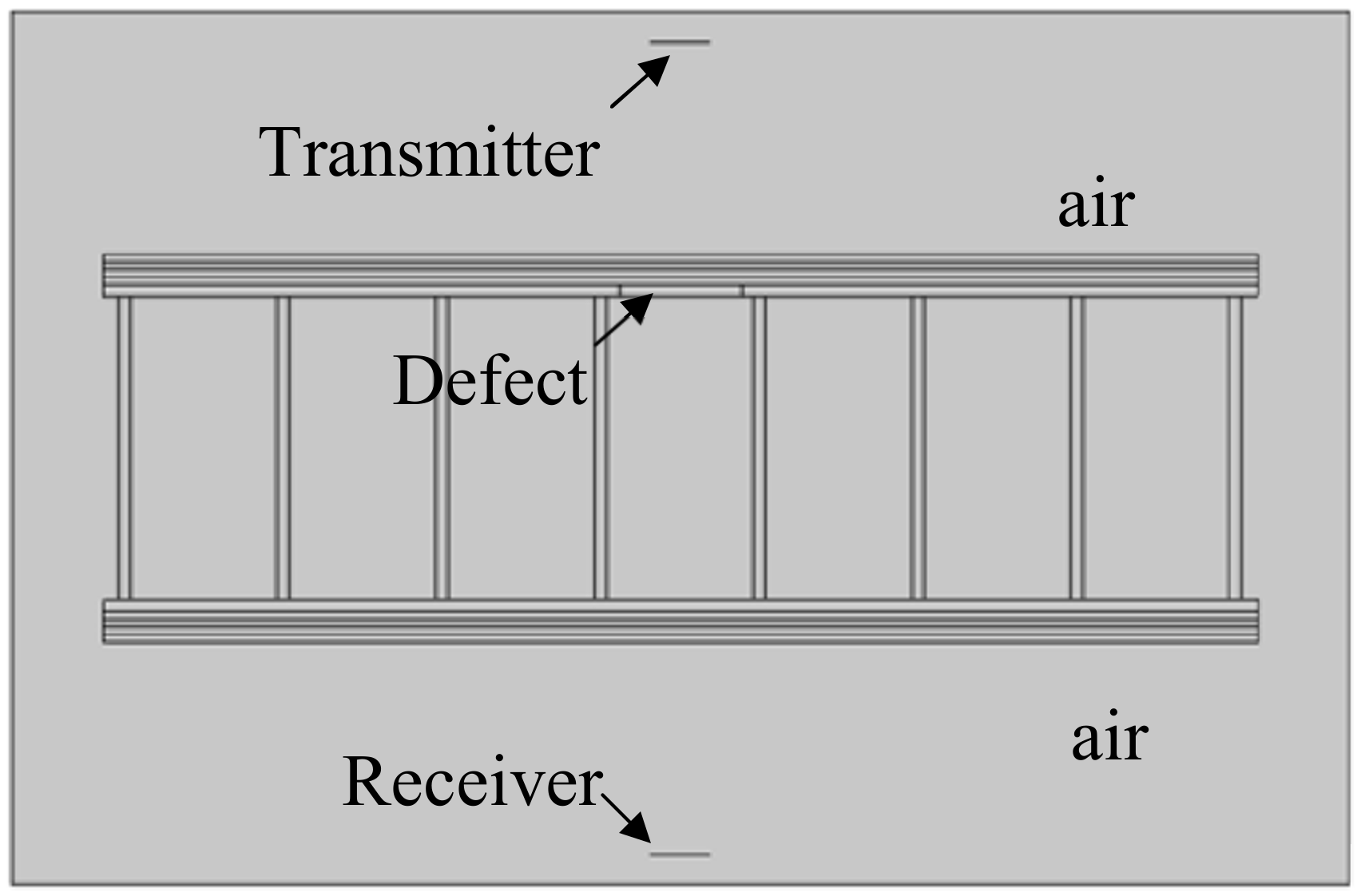
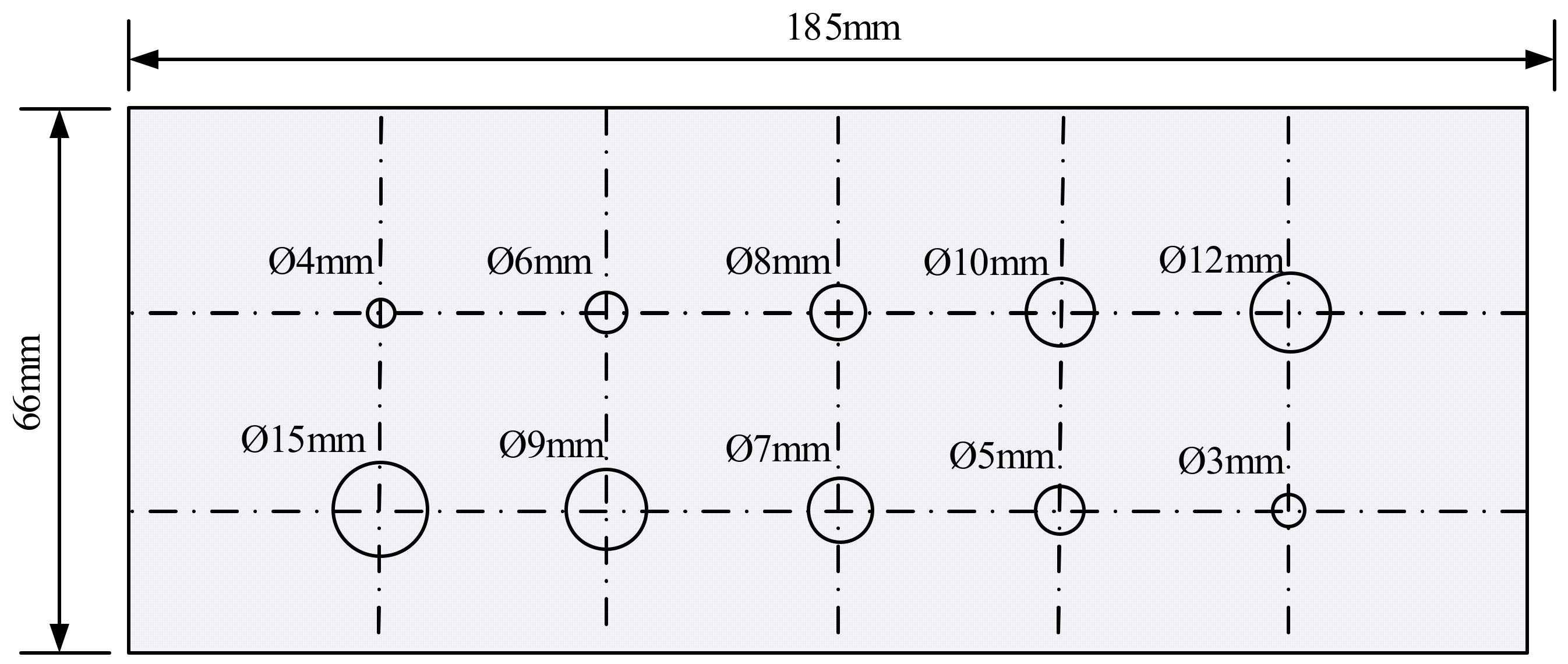
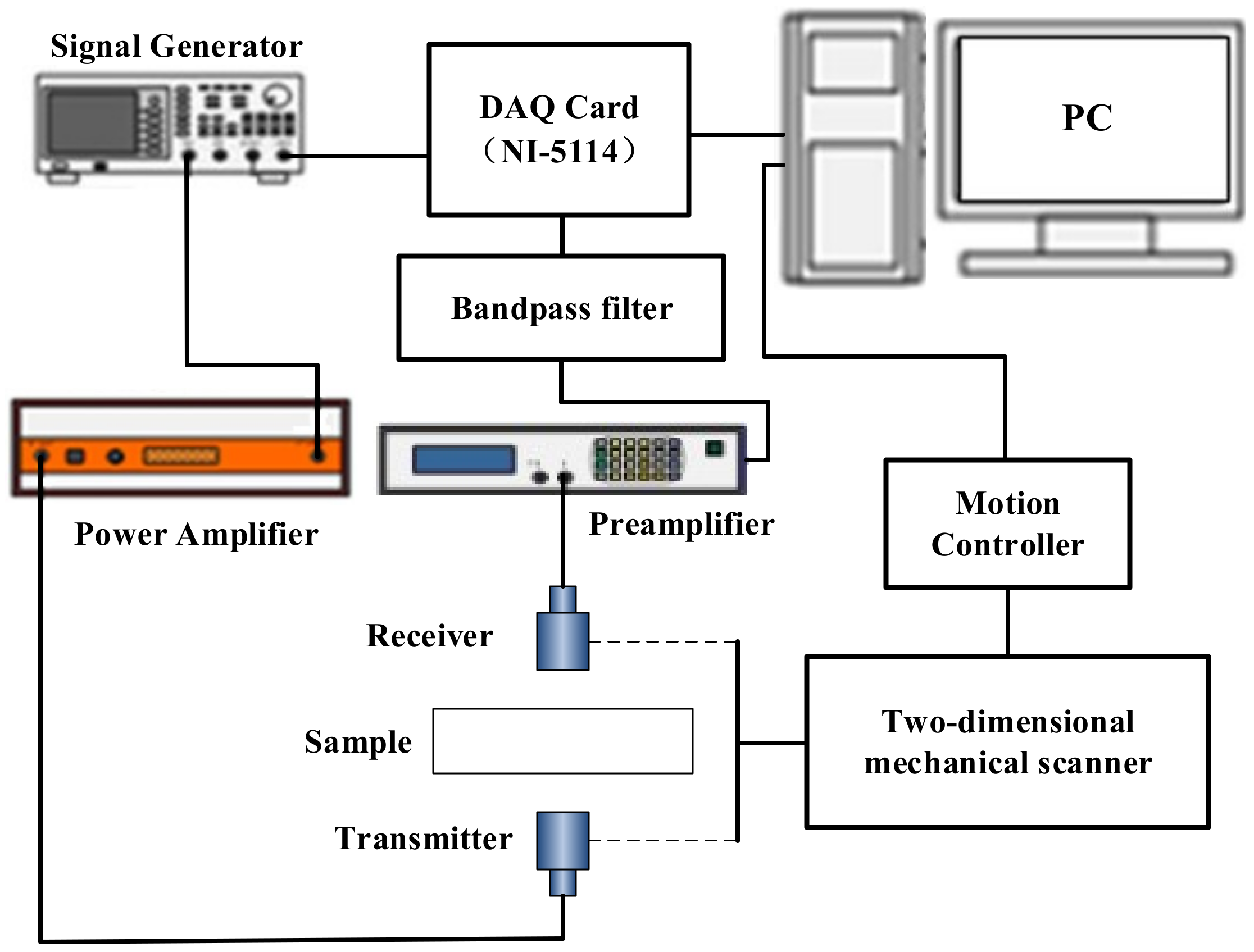


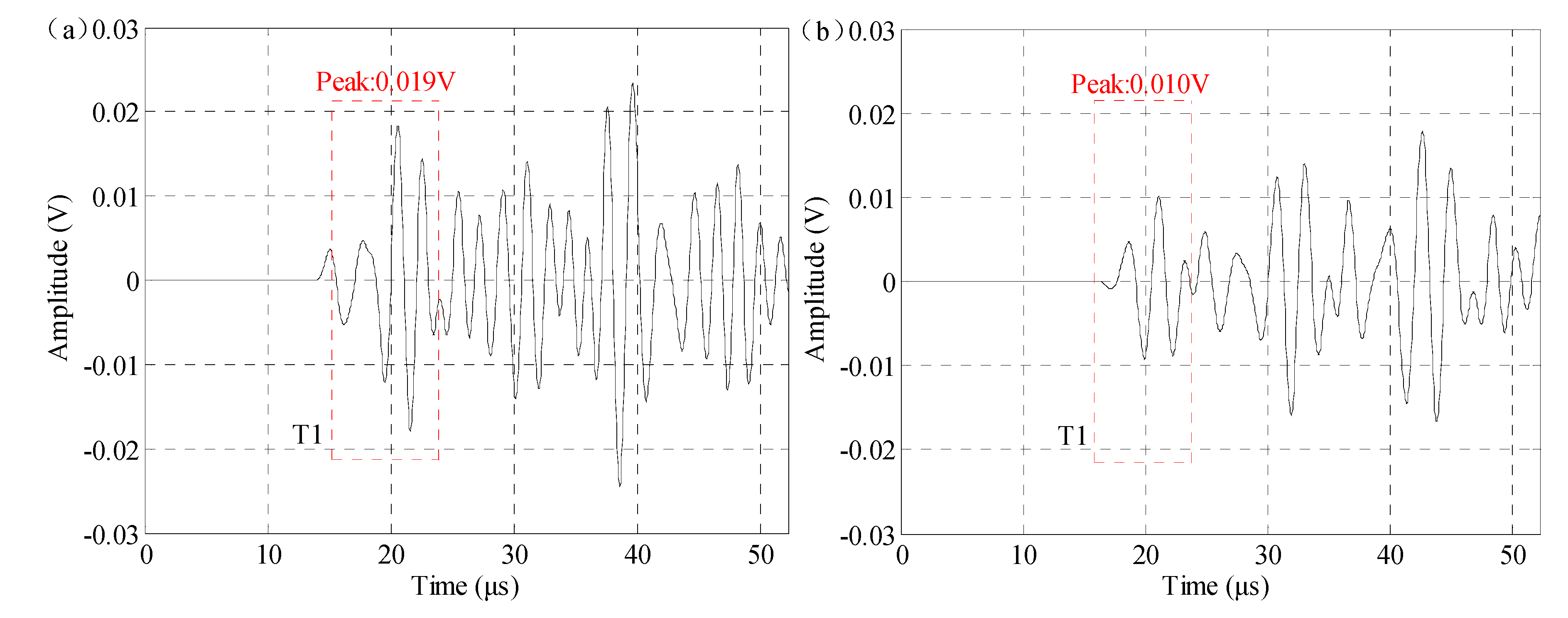
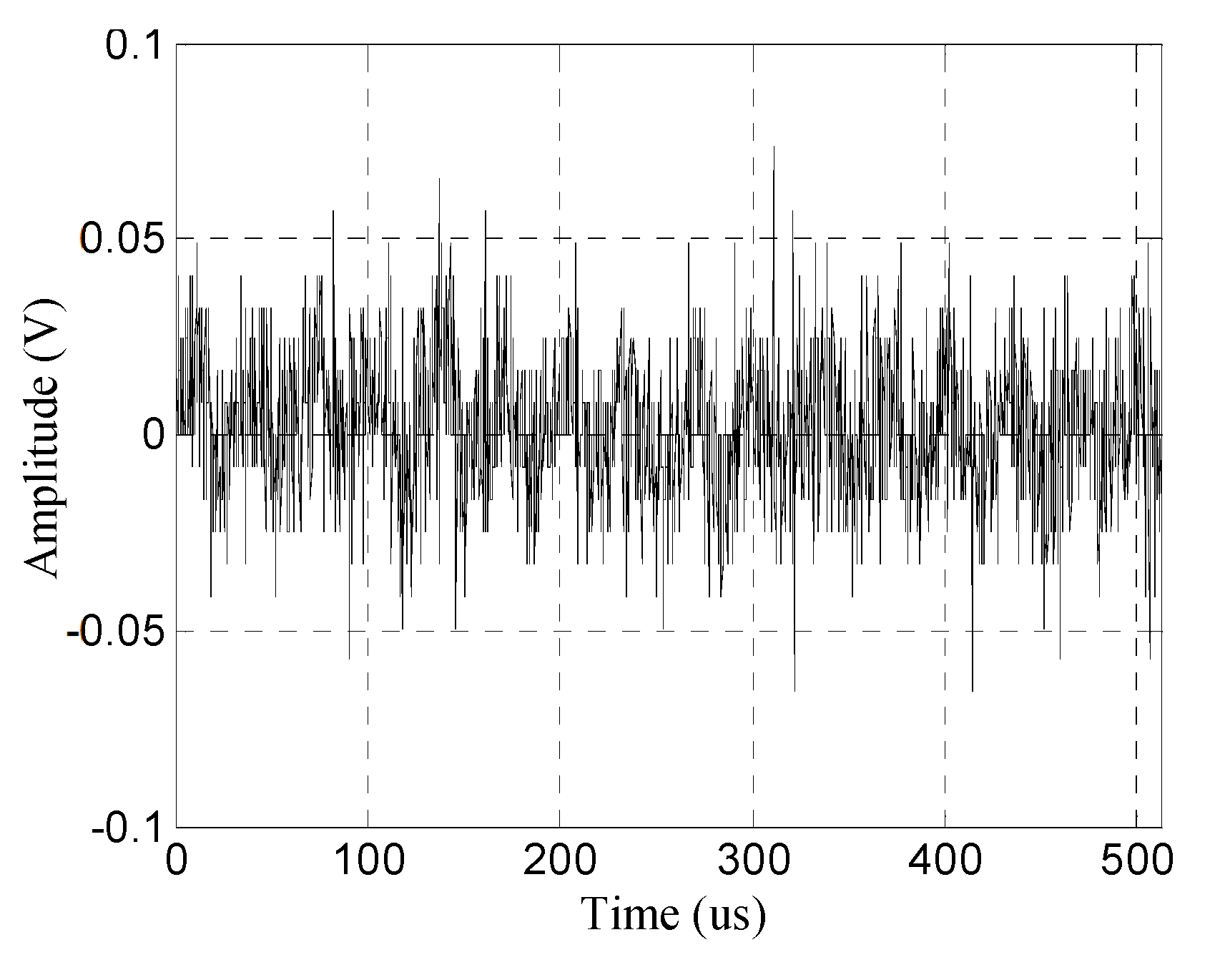


| Medium | Longitudinal Sound Velocity m/s | Shear Wave Velocity m/s | Mesh Size/μm |
|---|---|---|---|
| Air | 340 | - | 100 |
| Aluminum honeycomb core | 6260 | 3080 | 100 |
| Epoxy resin adhesive layer | 2800 | 1100 | 50 |
| GFRP | 2743 | 1380 | 50 |
| E1/MPa E3/MPa | E2/MPa | G21/MPa G23/MPa | G13/MPa | V12 | V21 V23 | V13 V31 |
|---|---|---|---|---|---|---|
| 23270 | 7750 | 2758 | 4580 | 0.41 | 0.13 | 0.15 |
| Solid Medium | Elastic Modulus/GPa | Poisson’s Ratio | Density/(Kg·m−3) |
|---|---|---|---|
| Aluminum | 6.8 | 0.32 | 2700 |
| Epoxy resin adhesive | 1 | 0.38 | 1180 |
© 2018 by the authors. Licensee MDPI, Basel, Switzerland. This article is an open access article distributed under the terms and conditions of the Creative Commons Attribution (CC BY) license (http://creativecommons.org/licenses/by/4.0/).
Share and Cite
Li, H.; Zhou, Z. Detection and Characterization of Debonding Defects in Aeronautical Honeycomb Sandwich Composites Using Noncontact Air-Coupled Ultrasonic Testing Technique. Appl. Sci. 2019, 9, 283. https://doi.org/10.3390/app9020283
Li H, Zhou Z. Detection and Characterization of Debonding Defects in Aeronautical Honeycomb Sandwich Composites Using Noncontact Air-Coupled Ultrasonic Testing Technique. Applied Sciences. 2019; 9(2):283. https://doi.org/10.3390/app9020283
Chicago/Turabian StyleLi, Honggang, and Zhenggan Zhou. 2019. "Detection and Characterization of Debonding Defects in Aeronautical Honeycomb Sandwich Composites Using Noncontact Air-Coupled Ultrasonic Testing Technique" Applied Sciences 9, no. 2: 283. https://doi.org/10.3390/app9020283
APA StyleLi, H., & Zhou, Z. (2019). Detection and Characterization of Debonding Defects in Aeronautical Honeycomb Sandwich Composites Using Noncontact Air-Coupled Ultrasonic Testing Technique. Applied Sciences, 9(2), 283. https://doi.org/10.3390/app9020283




